RDMA Environment Preparation and Installation¶
This chapter mainly introduces the parameters and instructions for RDMA when installing Spiderpool. Currently, RDMA supports the following two usage modes:
-
Based on Macvlan/IPVLAN CNI, using RDMA Shared mode to expose the RoCE NIC on the host to the pod. It is necessary to deploy the Shared Device Plugin to expose the RDMA NIC resources and schedule pods.
-
Based on SR-IOV CNI, using RDMA Exclusive mode to expose the RoCE NIC on the host to the pod. The RDMA CNI needs to be used to achieve RDMA device isolation.
Prerequisites¶
-
Please make sure that RDMA devices are available in the cluster environment.
-
Please make sure that the nodes in the cluster have mellanox NICs with RoCE. In this example, we use mellanox ConnectX 5 model NICs, and the proper OFED driver has been installed, if not, please refer to the document Install OFED Driver to install the driver.
Exposing RoCE NIC based on Macvlan/IPVLAN¶
-
When exposing the RoCE NIC based on Macvlan/IPVLAN, you need to make sure that the RDMA subsystem on the host is working in Shared mode. Otherwise, please switch to Shared mode.
-
Confirm the information of the RDMA NIC for subsequent device plugin discovery.
Enter the following command to view the vendor of the NIC, which is 15b3, and the deviceIDs, which is 1017. This information is required when deploying Spiderpool.
-
Install Spiderpool and configure the parameters related to the Shared Device Plugin. Please refer to Installing Spiderpool for deployment details.
Parameter Value Description RdmaSharedDevicePlugin.install True Whether to enable RdmaSharedDevicePlugin rdmaSharedDevicePlugin.deviceConfig.resourceName hca_shared_devices Define the name of the Shared RDMA Device resource, which needs to be used when creating Workloads rdmaSharedDevicePlugin.deviceConfig.deviceIDs 1017 Device ID number, consistent with the information queried in the previous step rdmaSharedDevicePlugin.deviceConfig.vendors 15b3 NIC Vendors information, consistent with the information queried in the previous step 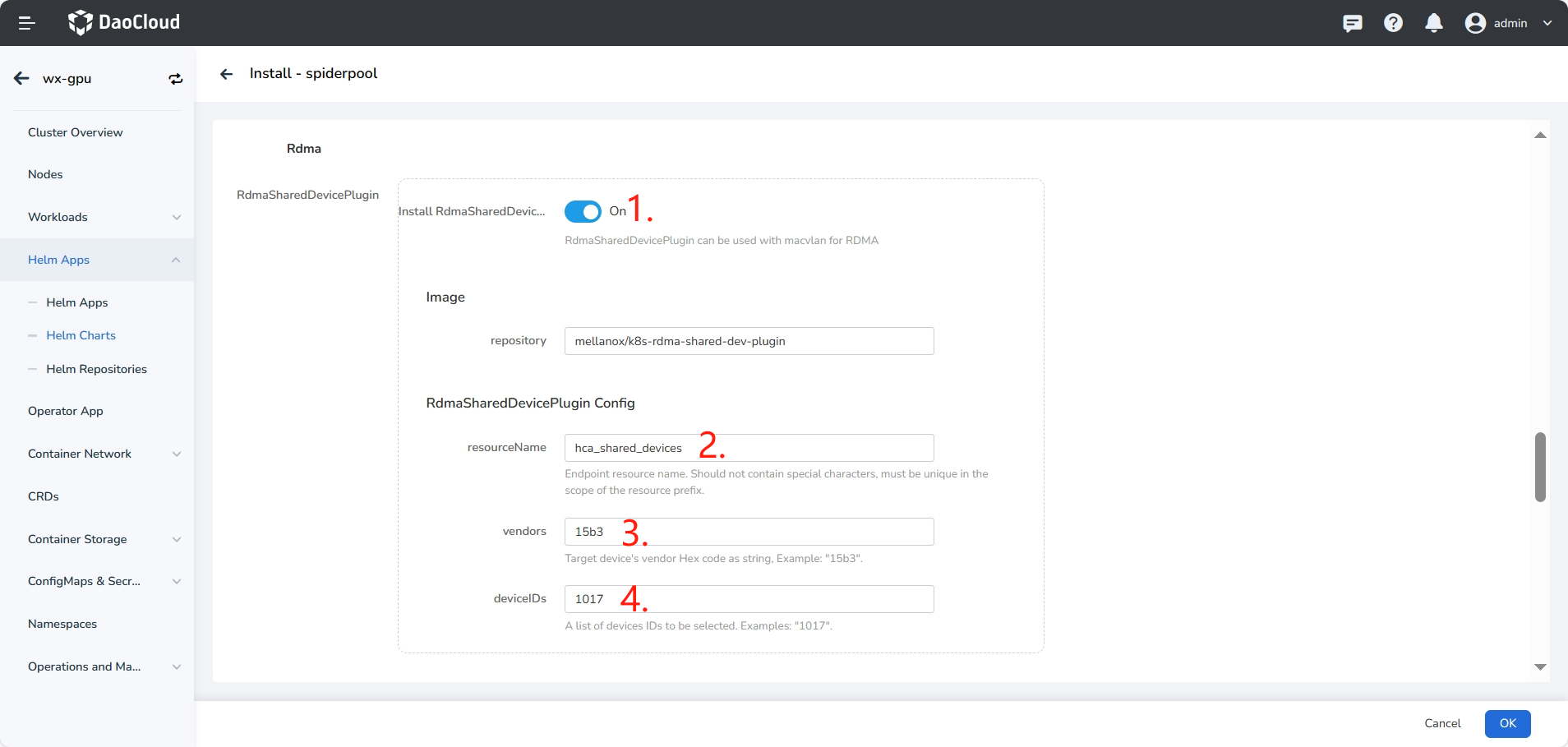
After successful deployment, you can view the installed components.
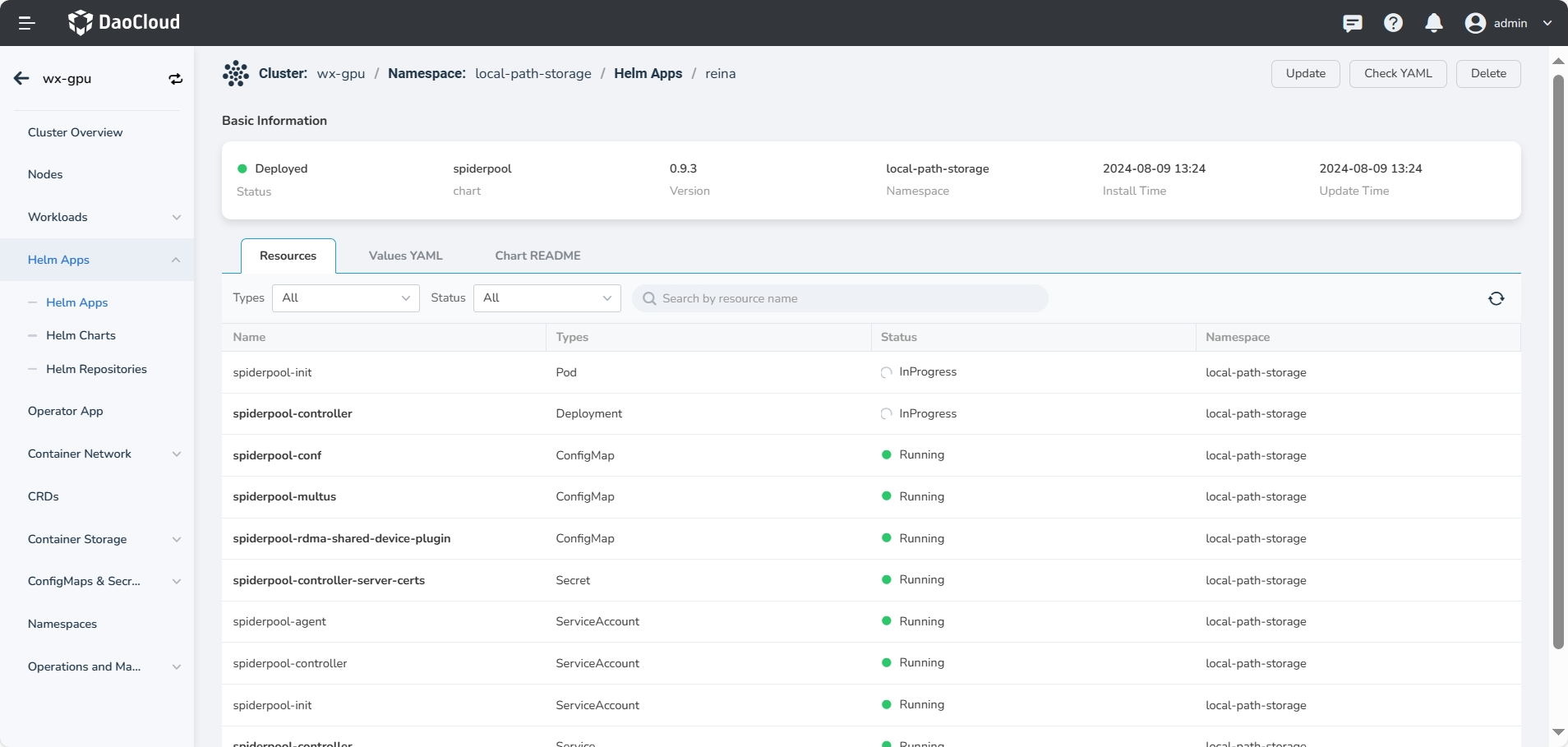
-
After the installation is complete, you can log in to the controller node to view the reported RDMA device resources.
kubectl get no -o json | jq -r '[.items[] | {name:.metadata.name, allocable:.status.allocatable}]' [ { "name": "10-20-1-10", "allocable": { "cpu": "40", "memory": "263518036Ki", "pods": "110", "spidernet.io/hca_shared_devices": "500", # Number of available hca_shared_devices ... } }, ... ]If the reported resource count is 0, possible reasons are:
- Please confirm that the vendors and deviceID in the Configmap spiderpool-rdma-shared-device-plugin match the actual ones.
- Check the logs of rdma-shared-device-plugin. For NICs that support RDMA, if the following error is found in the log, you can try to run
apt-get install rdma-coreordnf install rdma-coreon the host to install rdma-core.
-
If Spiderpool has been successfully deployed and the Device resources have been successfully discovered, please complete the following steps:
- Complete the creation of Multus instances, refer to Creating Multus CR
- Complete the creation of IP Pool, refer to Creating Subnets and IP Pool
-
After the creation is complete, you can use this resource pool to create workloads. Please refer to Using RDMA in Workloads for details. For more usage methods, please refer to Using IP Pool in Workloads.
Using RoCE NIC based on SR-IOV¶
-
When exposing the RoCE NIC based on SR-IOV, you need to make sure that the RDMA subsystem on the host is working in exclusive mode. Otherwise, please switch to exclusive mode.
-
Confirm that the NIC has SR-IOV functionality and check the maximum number of VFs supported:
The output is similar to:
-
Confirm the information of the RDMA NIC for subsequent Device Plugin discovery.
In this demo environment, the NIC vendors is 15b3, and the NIC deviceIDs is 1017. These information will be used when creating SriovNetworkNodePolicy in the next step.
The output is similar to:
-
Install Spiderpool and enable RDMA CNI and SR-IOV CNI. Please refer to Installing Spiderpool for installation details.
Parameter Value Description multus.multusCNI.defaultCniCRName sriov-rdma Default CNI name, specifies the name of the NetworkAttachmentDefinition instance used by multus by default.
- If the
multus.multusCNI.defaultCniCRNameoption is not empty, an empty NetworkAttachmentDefinition corresponding instance will be automatically generated after installation. - If the
multus.multusCNI.defaultCniCRNameoption is empty, an attempt will be made to create a corresponding NetworkAttachmentDefinition instance based on the first CNI configuration in the/etc/cni/net.ddirectory. Otherwise, a NetworkAttachmentDefinition instance nameddefaultwill be automatically generated to complete the installation of multus.
sriov.install true Enable SR-IOV CNI plugins.installRdmaCNI true Enable RDMA CNI 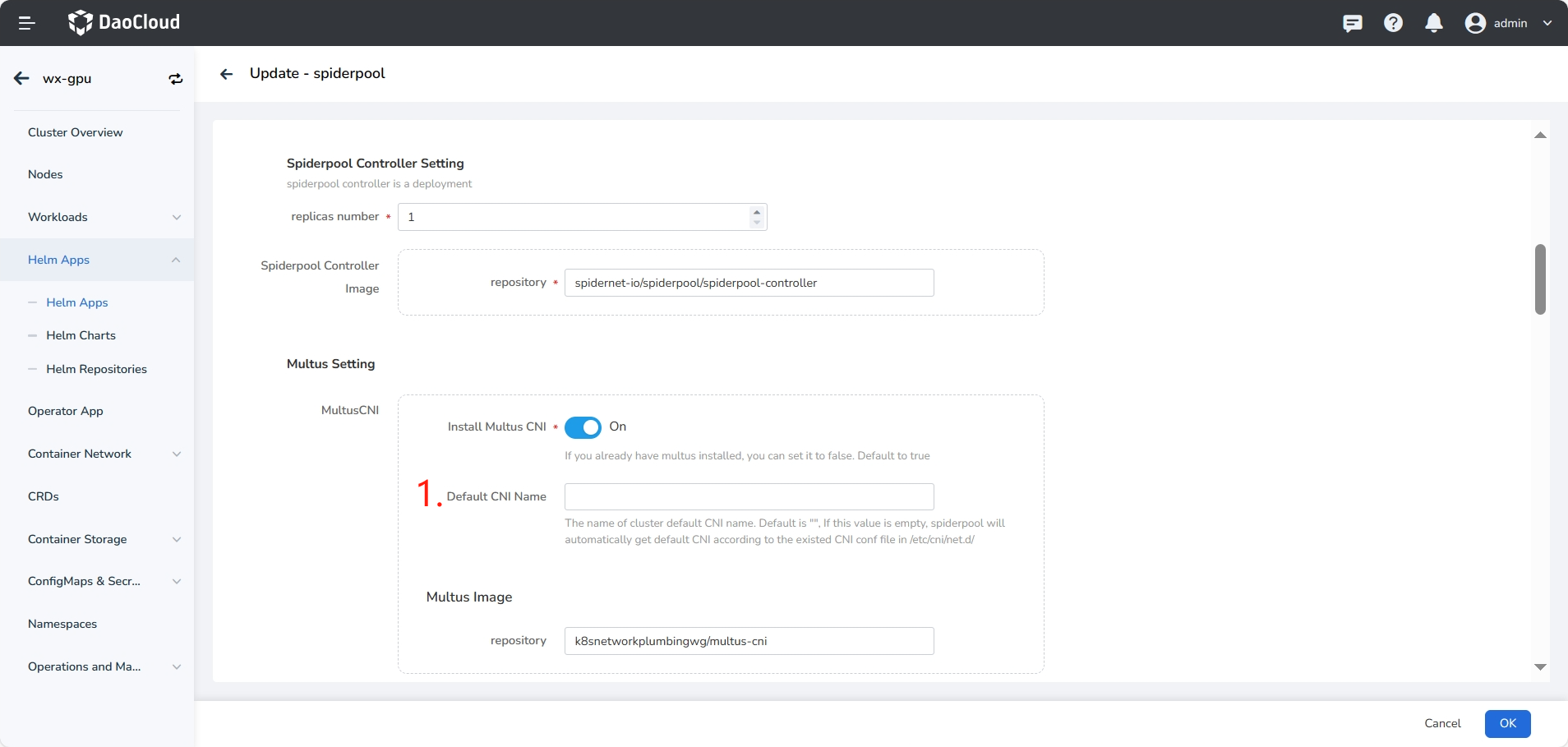
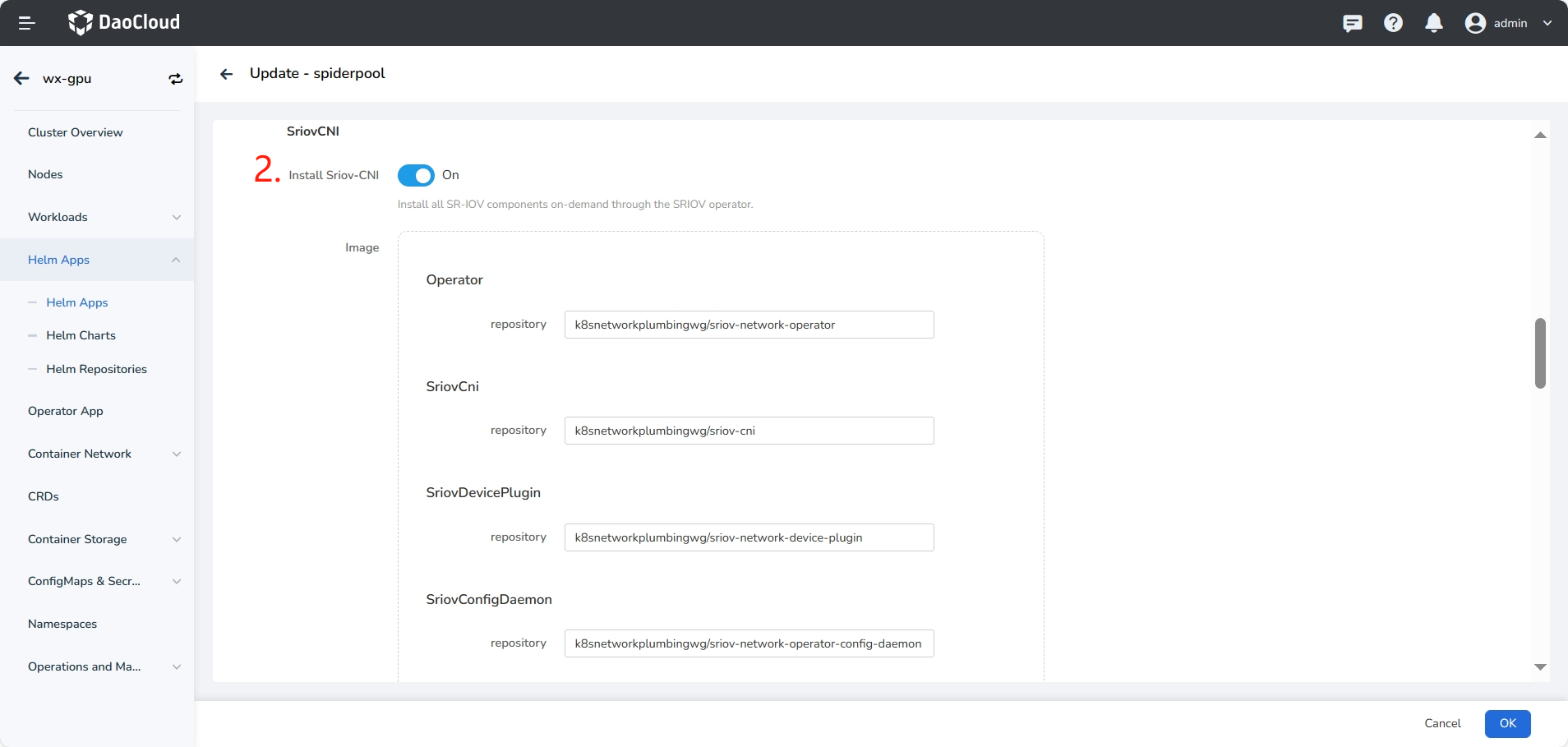
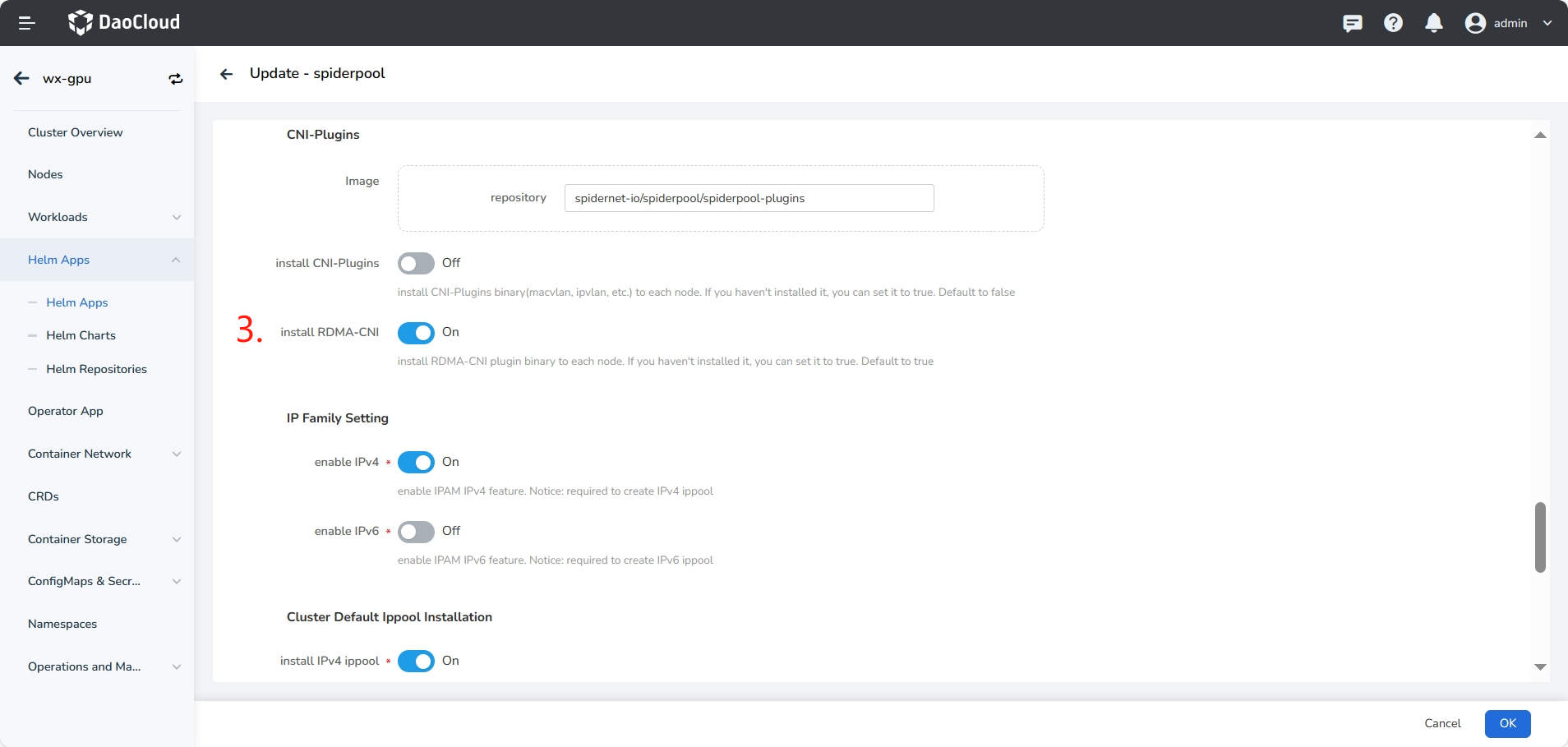
- If the
-
After the installation is complete, the installed components are as follows:
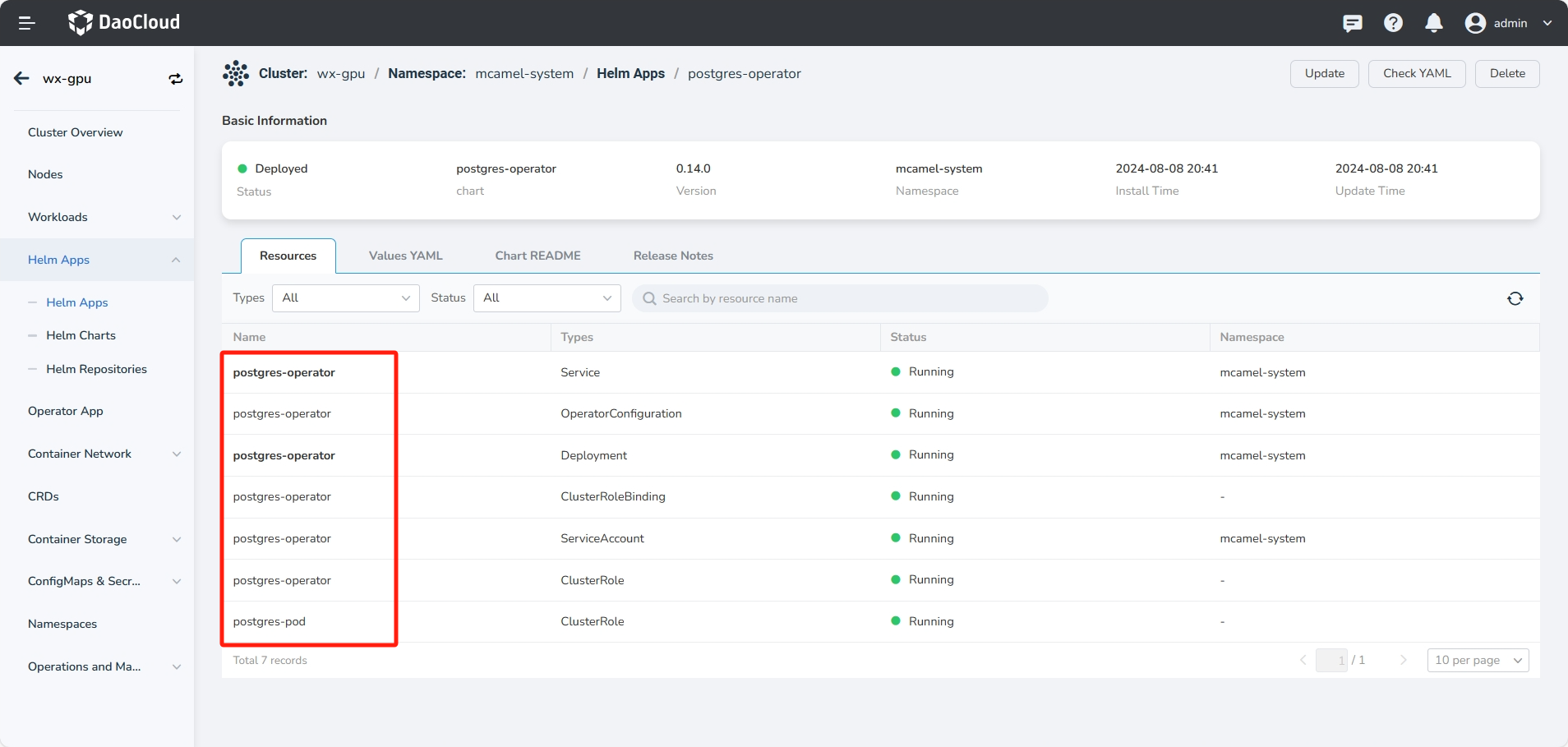
-
Refer to the following SriovNetworkNodePolicy configuration to allow the SR-IOV Operator to create VFs on the host and report resources.
The YAML configuration is as follows:
apiVersion: sriovnetwork.openshift.io/v1 kind: SriovNetworkNodePolicy metadata: name: policyrdma namespace: kube-system spec: nodeSelector: kubernetes.io/os: "linux" resourceName: mellanoxrdma # Custom resource name, used when creating applications priority: 99 numVfs: 8 # Number of available numVFS, cannot be greater than the maximum available number queried in step 2 nicSelector: deviceID: "1017" # Device ID queried in step 3 rootDevices: # rootDevices pfNames queried in step 3 - 0000:04:00.0 vendor: "15b3" # NIC vendors queried in step 3 deviceType: netdevice isRdma: true # Enable RDMAInterface configuration:


-
After the installation is complete, check the available device resources:
kubectl get no -o json | jq -r '[.items[] | {name:.metadata.name, allocable:.status.allocatable}]' [ { "name": "10-20-1-220", "allocable": { "cpu": "56", "ephemeral-storage": "3971227249029", "hugepages-1Gi": "0", "hugepages-2Mi": "0", "memory": "131779740Ki", "pods": "110", "spidernet.io/hca_shared_devices": "0", "spidernet.io/mellanoxrdma": "8", # Number of available device resources ... } } -
If Spiderpool has been successfully deployed and the Device resources have been successfully discovered, please complete the following steps:
- Complete the creation of Multus instances, please refer to Creating Multus CR
- Complete the creation of IP Pool, please refer to Creating Subnets and IP Pool
After the creation is complete, you can use this resource pool to create workloads. Please refer to Using RDMA in Workloads for details. For more usage methods, please refer to Using IP Pool in Workloads.